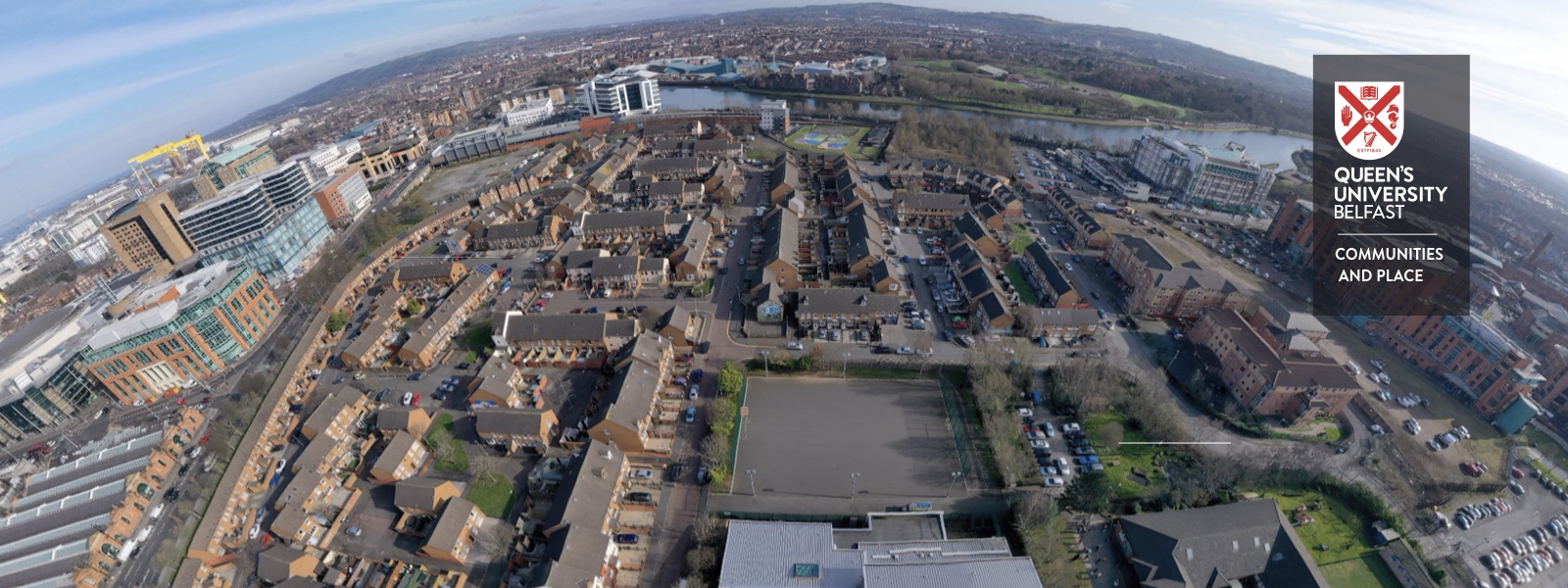Implications for People, Policy and Practice
The first year of the Growing up in the Market (GUIM) study has yielded many insights, which are highly relevant to the community and the partnership with QCAP. Many of these insights have already resulted in action in the form of projects and interventions. Furthermore, these insights will be of interest to policymakers concerned with hearing a community voice on a range of social issues.
Data elicited from the first phase of GUIM interviews demonstrate how, for most adults and young people, the close bonds and connectedness of family and neighbourhood life are important resources for generating positive self-conscious emotions such as pride, trust and hope. These findings reinforce the existing literature on the social determinants of wellbeing and the role that community connections, social networks and social cohesion have in enhancing individual and community wellbeing[1][2][3]. Our findings are in keeping with the recent review of the ONS Measures of National Wellbeing, which have added several new measures considered important drivers of wellbeing which include ‘Hope for the Future, Fair treatment and Local community integration’ among others[4]. However, findings also revealed that existing tensions around increased substance use, and the changing social composition of the area showed potential for disrupting these networks and, consequently, increasing risks to people’s wellbeing.
Support for place-based approaches, and using participatory approaches to involve the community in policy making
A key policy message follows that maintaining and developing these networks can preserve valuable social resources that promote social development and health for local communities. Our findings offer strong support for policies and interventions which enhance opportunities to engender positive self-conscious emotions like pride and hope, for example by using participatory approaches and valuing lived experience when public policy is being formulated, particularly policies relating to neighbourhood and place.
Better signposting to and accessibility of services.
The findings further suggest that it is important to understand how people living in this community negotiate boundaries and that this is relevant to the delivery of health, education and other social supports. Most respondents agreed that existing services located outside of the community were difficult to understand, navigate and access. Given the high rate of mental ill health [5] and substance use[6] in NI, discovering how to improve access to services is crucial. People need information about existing services, and how to access them. While some respondents expressed a preference for services within the community others suggested that this would be less satisfactory due to privacy issues in such a close-knit area. These findings indicate that accessibility needs to be closely considered when designing and planning services.
Support for trauma informed practice
There were clear indications of the impact of trauma on the community as respondents shared collective and individual experiences of adversity. This is borne out by the increasing levels of substance use. This would suggest that addressing the intergenerational trauma and the transmission of adversity is needed to ensure the effectiveness of potential policies or interventions. In 2020, the Safeguarding board NI [7] published guidelines regarding trauma informed practice in health, social care, justice, education, and community and voluntary systems in NI. The evidence from this study suggests that there need to be further attention paid to implementing a trauma informed approach across the board, including in education and within our research partnership.
Support for whole-community approaches to education
The headline education finding from year 1 in is that residents' experiences of education are rooted in the socio-emotional context of the community. By this we mean that persistent exposure to adversity in the form of legacy issues, economic pressures, local substance use, and various perceived injustices have had a profound influence on how residents perceive and engage with institutional structures, including education. Connected to this was the broad perception that pathways in education are linear, fixed, and determined by academic ability—an interpretation of how residents discussed narrow definitions of success, qualifications as currency, and well-worn pathways from the local primary school to non-selective post-primary and early school-leaving, alongside constrained options and opportunities. This perceived rigidity of educational pathways appears as a barrier to residents from exploring alternative routes to success.
Alternative pathways through education into employment should be better signposted, rooted in local context and informed by local voices and data. For this to happen, NI Education policy frameworks need to enable and support communities to become more involved in the design and delivery of provision.
We recommend that the actions within the Fair Start action plan, specifically around key area 4 “Promoting a Whole-Community Approach to Education,” be fully implemented. We also note that the end-to-end review of school improvement also provides an opportunity to reframe the role that community contexts have in relation to family-school engagement, with our data reinforcing the need for place-based approaches and interventions that genuinely support the involvement of residents and integration of local lived perspectives.
Digital inclusion
Digital inclusion was identified as the challenge area for year one of GUIM. The Covid-19 lockdowns and the coinciding increased use of online services and platforms had underscored the digital divide and how under-resourced communities are adversely affected by digital poverty. The data gathered through GUIM offers a more nuanced picture of digital inclusion and the barriers encountered by residents during lockdowns and since emerging from them.
In reference to education, a high number of parents conceded that they lack digital awareness, hindering their ability to fully support their children with homework and creating some apprehension around online communication with the school. There was widespread agreement among all our respondents on the need for children to have access not just to a device, but to have an appropriate device for each child. The Department of Education’s Fair Start Action Plan in 2021 committed to supporting equitable access to learning by providing appropriate devices to schools with high levels of FSME and delivered over 9000 devices, which far exceeded targets[8]—a positive achievement. The challenge now is providing schools with the necessary levels of IT support for maintaining and refreshing these devices, whilst also honouring commitments made within the Fair Start action plan to give staff the necessary training to develop their own digital skills and support pupils.
These findings align with the Digital Skills in Northern Ireland report (NISRA, 2023) that highlights lower levels of basic digital skills in adult populations living in the region’s most deprived areas[9]. The GUIM data also demonstrate that the development of digital poverty programmes, such as the NI Executive’s project Stratum[10], need to be supported by a range of policies and strategies that not only focus on infrastructural challenges, but that help parents to have access to skills and supports to effectively participate in an increasingly digital society. This is particularly relevant for the Market community who sit as the only one in inner-Belfast within the footprint of Belfast’s emergent innovation district as part of the Urban Innovation Framework and Smart Belfast[11]. We reiterate recommendations made by the community and voluntary sector that a more comprehensive digital strategy for NI is required—one that prioritises digital inclusion. Additionally, policies aiming to improve digital access should include mechanisms that allow communities and/or schools flexibility to decide what devices would be appropriate for their context and meet local need. Offers of equipment should be accompanied by free digital skills training, particularly for those groups identified as most vulnerable to digital exclusion.
Conclusion
It was a positive finding that many of our parent respondents had hope that things might be better for their children than what they had experienced growing up. Maintaining hope requires people to trust that the government will work to make a difference in the lives of our young people and work in their best interests[12]. Recent research which measures the wellbeing of people across the UK reports a ‘democratic crisis’ in NI, with levels of trust in government and other institutions much lower in NI than elsewhere in the UK, with most people feeling that they cannot influence the NI Executive or local level decision makers[13]. One of the most important implications for the NI Executive, is the fundamental need to build trust with the people by proving it understands local people’s priorities.
[1] McElroy, E., Ashton, M., Bagnall, A.M., Comerford, T., McKeown, M., Patalay, P., Pennington, A., South, J., Wilson, T. and Corcoran, R., 2021. The individual, place, and wellbeing–a network analysis. BMC Public Health, 21, pp.1-10.
[2] Linton, M.J., Dieppe, P. and Medina-Lara, A., 2016. Review of 99 self-report measures for assessing well-being in adults: exploring dimensions of well-being and developments over time. BMJ open, 6(7).
[3] Roffey, S., 2013. Inclusive and exclusive belonging: The impact on individual and community wellbeing. Educational and Child Psychology, 30(1), pp.38-49.
[4] Office for National Statistics (ONS) released 5 July 2023, ONS website, article, Review of the UK Measures of National Well-being, October 2022 to March 2023.
[5] Bunting, L., McCartan, C., Davidson, G., Grant, A., McBride, O., Mulholland, C., Murphy, J., Schubotz, D., Cameron, J. and Shevlin, M., 2020. The mental health of children and parents in Northern Ireland: Results of the youth wellbeing prevalence survey.
[6] https://www.gov.uk/government/statistics/substance-misuse-treatment-for-adults-statistics-2022-to-2023
[7] Safeguarding Board of Northern Ireland, 2020, https://www.safeguardingni.org/sites/default/files/2020-11/ACEs%20Report%20A4%20Feb%202019%20Key%20Messages.pdf
[8] https://www.education-ni.gov.uk/sites/default/files/publications/education/OBA%20Report%20card%20-%20Publisher%2029.11.2023.pdf
[9] https://datavis.nisra.gov.uk/economy-and-labour-market/digital-skills-in-northern-ireland-22-23.html
[10] Northern Ireland Executive (2021) ‘Check where and when broadband improvement scheme will be rolled out’ Available at: https://www.northernireland.gov.uk/node/49098
[11] https://smartbelfast.city/story/belfast-urban-innovation-framework-2022-2026/
[12] Pleeging, E., Burger, M. & van Exel, J. The Relations between Hope and Subjective Well-Being: a Literature Overview and Empirical Analysis. Applied Research Quality Life 16, 1019–1041 (2021). https://doi.org/10.1007/s11482-019-09802-4
[13] Life in the UK 2023 Northern Ireland - Carnegie UK Trust

